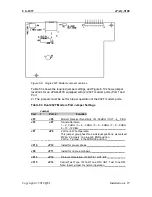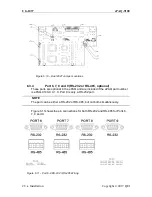
UG-1037
ePAQ-9100
Copyright © 2016 QEI
Hardware Overview
13
6
Port #6
IED Communications Ports
RS-232 or RS-485 (2 Wire)
Byte Oriented
Asynchronous
150
– 38,400 bps
7
Port #7
IED Communications Ports
RS-232 or RS-485 (2 Wire)
Byte Oriented
Asynchronous
150
– 38,400 bps
8
Port #8
IED Communications Ports
RS-232 or RS-485 (2 Wire)
Byte Oriented
Asynchronous
150
– 38,400 bps
9
Port #9
IED Communication Port
RS-232
Byte Oriented
Asynchronous
150-38,400 bps
3.2.1
Ports #1 and #2
These two ports are normally assigned to be the main communication link(s) to
one or more Master Stations (servers). Both of these ports have identical
functionality and capabilities. They can support synchronous and asynchronous,
bit and byte oriented communication protocols at various baud rates, and either
RS-232 or Bell 202T communication standards. Each of these two ports has TX
and RX LED’s located on the Front Panel of the ePAQ-9100.
3.2.2
Port #3 (Maintenance Port)
This port utilizes the Serial Communication Interface built into the 68331.
It is called the Maintenance Port because its main function is to provide a clean,
simple interface to the test technician, allowing him to control and query the
status of the ePAQ-9100 or its data. This port is also used for downloading
software, configuration tables, etc. This is an RS-232 interface port supporting
only software handshaking. Connections can be made to it through a DB9
Female connector located on the front panel of the ePAQ-9100.
3.2.3
Port #4
This is an RS-232 interface port and can be configured to handle any mode or
protocol supported by the ePAQ-9100 program. A DB9 Female connector is used
for connections to an external communications device, such as an RS-232
interface modem or radio. RS-232 signals in this connector are:
A Push-To-Talk (PTT) signal is provided and can be used to key an external
radio, if needed. This output is in the form of an open collector output.
This port has TX and RX LEDs for communications status on the ePAQ-
9100’s
front panel.
3.2.4
Port #5
This is an RS-485 interface port normally used to communicate with Intelligent
















































